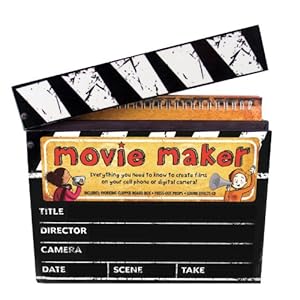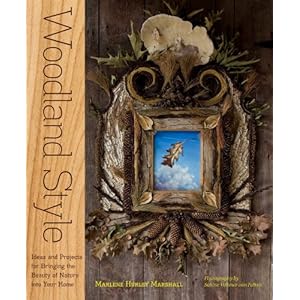Originally published in the Santa Cruz Sentinel, December 4, 2010
For the crafter of any age or inclination on your holiday shopping list, books are a welcome gift. From home decoration to wedding planning to backyard fun to photo and movie making—books are full of innovative ideas and well-illustrated step-by-step instructions. The best of them encourage cooperative planning/construction and earth-friendly materials. Here are a few to consider this holiday season.
For kids:

Movie Maker
The Ultimate Guide to Making Films
By Tim Grabham , Suridh Hassan, Dave Reeve, Clare Richards, Garry Parsons (Illustrator)
Candlewick
If your child has ever put on a play, a puppet show, or knows who Steven Spielberg is, why not encourage his/her inner filmmaker? Movie Maker is a kit to help kids make movies using a digital camera or cell phone. Aimed at children age 8-12, the box (which doubles as a working clapper board) includes a CD of sound effects, small push-out costume accessories and props, a fill-in storyboard, and a 48-page step-by-step director’s handbook. Extras such as stickers for the director's chair, stars for the actors' dressing rooms, and tickets for the premiere of the movie make this a complete experience.
For parents:

Handy Dad
25 Awesome Projects for Dads and Kids
By Todd Davis
Chronicle Books
Here’s your chance to enter the hallowed ranks of best dad (or mom for that matter) in the world. Flip through this book with your offspring so that you can plan your chosen project together. Picture your daughter scaling a colorful Climbing Wall in her own backyard or your son flying from tree to tree on his very own Zip Line. Assuming you have the tools and the knowhow, the projects take 10 minutes, “one beer,” an afternoon or a weekend and there’s something here for children of every age and interest, including a lava lamp, a water balloon launcher, a dollhouse, a half pipe, a treasure chest, a go cart, a circus tent, and (my favorite) a stunt dummy/abominable snowman.
For the bride and groom:

Crafty Ideas for the
Bride on a Budget
Edited By Linda Kopp
Lark Books
A budget wedding doesn’t have to be a drab one, or even a noticeably low-cost one—as the elegant projects in this book attest to. You can save money by making your own invitations, bouquets, flower girl basket, ring pillow, seating cards, centerpieces, favors and thank you notes—especially if you’ve got the tools and a few crafty friends to lend a hand. “Budget” has included the essential and ephemeral in its 75 projects—even several wedding cakes—but made me question the budget premise. Another budget-wedding book, “The DIY Bride Crafty Countdown” by Khris Cochran, actually provides a “Crafty Calculator” comparing your cost vs. store cost for each of its 40 wedding projects, and avoids pricier materials like the satin ribbon and large silk flowers used in “Budget.” However some of the projects, such as “Groovy Owl Cake Toper” and “Gourmet Popcorn Buffet,” didn’t look groovy, gourmet, or even appropriate for the most economical of weddings.
For the techie:

Fashioning Technology
A DIY Intro to Smart Crafting
By Syuzi Pakhchyan
Make Books
When geek and designer get together amazing things happen. “Fashioning Technology” is a beginners’ guide to integrating simple electronics with wearables, home accents and interactive toys. The author is a robotics instructor with an art background, whose projects are both fashionable and useful. Wearable projects include headphones that keep your ears warm and have lights for added safety at night. For the home, you can make a luminescent tea table or an LED chandelier. “Smart materials” used in project construction include thermo- and photochromatic inks, magnetic and conductive paints, polymorph plastic and fiber optics. For forward-thinking crafters, it’s time to learn some a new vocabulary and put it to great use. (This isn’t a new book, but it’s the best one I’ve seen yet for teaching the basic techniques of technology-based crafts.)
For the photographer:

Photojojo!
Insanely Great Photo Projects and DIY Ideas
By Amit Gupta and Kelly Jensen
Potter Craft
“Photojojo!” isn’t a book for would-be Ansel Adamses who painstakingly print, mat and frame their images for the gallery. It’s for those who love to be surrounded by lots and lots of photographs, everyday, in fun and unexpected ways. Access to a camera, a computer, and image-editing software are requisite, but most of the projects don’t require lots of shopping for materials. Create a mural-sized photo displayed in multiple re-purposed CD jewel cases, a photo easel from an old fork, or cupcakes crowned with edible photo icing. “Photojojo!” aims to get you shooting and using your photographs more creatively.
For the daydreamer:

Woodland Style
Ideas and Projects for Bringing Foraged and Found Elements Into Your Home
By Marlene Hurley Marshall
Storey Publishing
Even the cover incorporates wood (literally) in this book about home décor made from things found in the woods. Anything tree-related that can be preserved such as twigs, roots, seedpods, bark or logs is fair game, as well as greenery such as mosses. With an emphasis on lovely photos intended to spark ideas, the book also offers instructions for a few simple projects such as a moss wreath or leaf garland, and recipes for cooking with wild edibles. It’s a celebration of the dark, damp, woodsy side of nature, and an exploration of decorative ways to bring those rustic elements indoors.

































